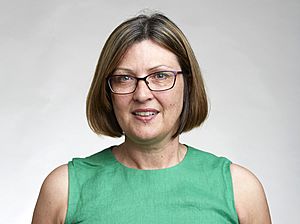Tracy Palmer facts for kids
Quick facts for kids
Tracy Palmer
FRS FRSE FMedSci
|
|
|---|---|

Tracy Palmer at the Royal Society admissions day in London, July 2018
|
|
| Born | 8 May 1967 Sheffield, England
|
| Education | University of Birmingham (BSc, PhD) |
| Spouse(s) |
|
| Children | James Sargent (b. 2000), Jack Sargent (b. 2002) |
| Awards | EMBO Member (2017) Royal Society University Research Fellowship (1996) |
| Scientific career | |
| Fields | |
| Institutions | Newcastle University University of Dundee University of East Anglia John Innes Centre |
| Thesis | The kinetics of the proton-translocating transhydrogenase from photosynthetic bacteria (1992) |
| Doctoral advisor | J. Baz Jackson |
Tracy Palmer is a British scientist who studies tiny living things called microbes or bacteria. She is a professor of microbiology at Newcastle University in England. She is famous for her important work on how bacteria move special proteins around, especially through something called the twin-arginine translocation (Tat) pathway.
Contents
Early Life and School
Tracy Palmer was born in Sheffield, England, on May 8, 1967. Her dad worked with steel. She grew up in a town called Stocksbridge and went to high school there.
She later went to the University of Birmingham. In 1988, she earned a degree in biochemistry, which is the study of the chemical processes happening inside living things. In 1992, she earned her PhD, which is a very high university degree. For her PhD, she studied how a special protein pump works in bacteria that use sunlight for energy. She was inspired by another scientist, Peter D. Mitchell, who studied how cells make energy.
Career and Discoveries
Professor Palmer's main research is about how bacteria send proteins out of their cells. Imagine bacteria as tiny factories; they need to send out certain products (proteins) to do their jobs.
The Tat System
One of her biggest discoveries was helping to find the bacterial Tat protein secretion system. This system is very special because it can move proteins that are already folded into their correct shapes across the bacteria's outer layer, called a biological membrane. It does this without letting other tiny particles, called ions, leak out. This is like moving a fully built car through a wall without making a hole!
Type VII Secretion System
Professor Palmer also started studying another way bacteria move proteins, called the Type VII secretion system (T7SS). She studied this in a type of bacteria called Staphylococcus aureus, which can cause infections in humans. Her team showed that this T7SS helps bacteria fight each other. The S. aureus bacteria use it to send out a harmful substance that stops other similar bacteria from growing.
Working at Universities
After her PhD, Tracy Palmer worked at the University of Dundee from 1992 to 1996. She then received a special research award from the Royal Society in 1996. This allowed her to start her own research group at the John Innes Centre in Norwich, while also being connected to the University of East Anglia.
While in Norwich, she worked closely with Professor Ben C. Berks. Together, they won the Microbiology Society Fleming Prize Lecture in 2002 for their work on the Tat system.
In 2007, Professor Palmer moved back to the University of Dundee. She led the Division of Molecular Microbiology there for many years. In 2018, she moved to Newcastle University, where she now leads a research group that studies how microbes affect health and disease.
Professor Palmer has also helped the microbiology community by being an editor for important science journals like Microbiology and Molecular Microbiology. She also helps decide who gets research jobs at The Royal Society.
Awards and Special Recognitions
Professor Tracy Palmer has received many important awards for her scientific work:
- In 2018, she was chosen as a Fellow of the Royal Society (FRS). This is a very high honor for scientists in the United Kingdom, given for making "major contributions to science."
- In 2009, she became a Fellow of the Royal Society of Edinburgh (FRSE), which is a similar honor in Scotland.
- She is also a Fellow of the American Academy of Microbiology and a member of the European Molecular Biology Organization (EMBO).
- In 2021, she was elected as a Fellow of the Academy of Medical Sciences.

